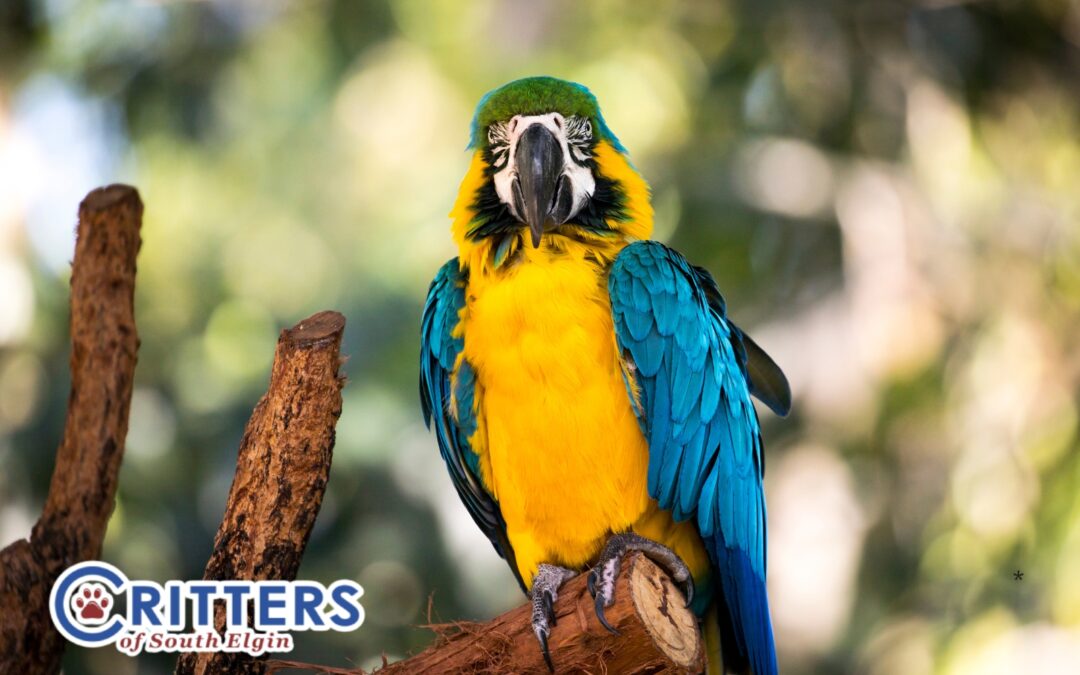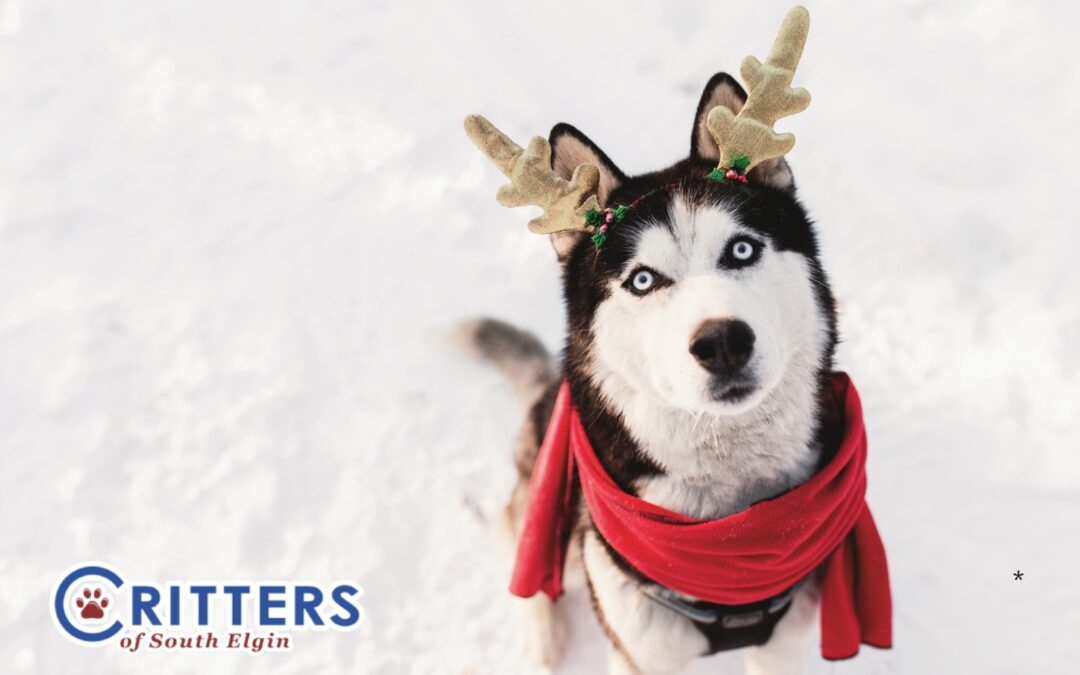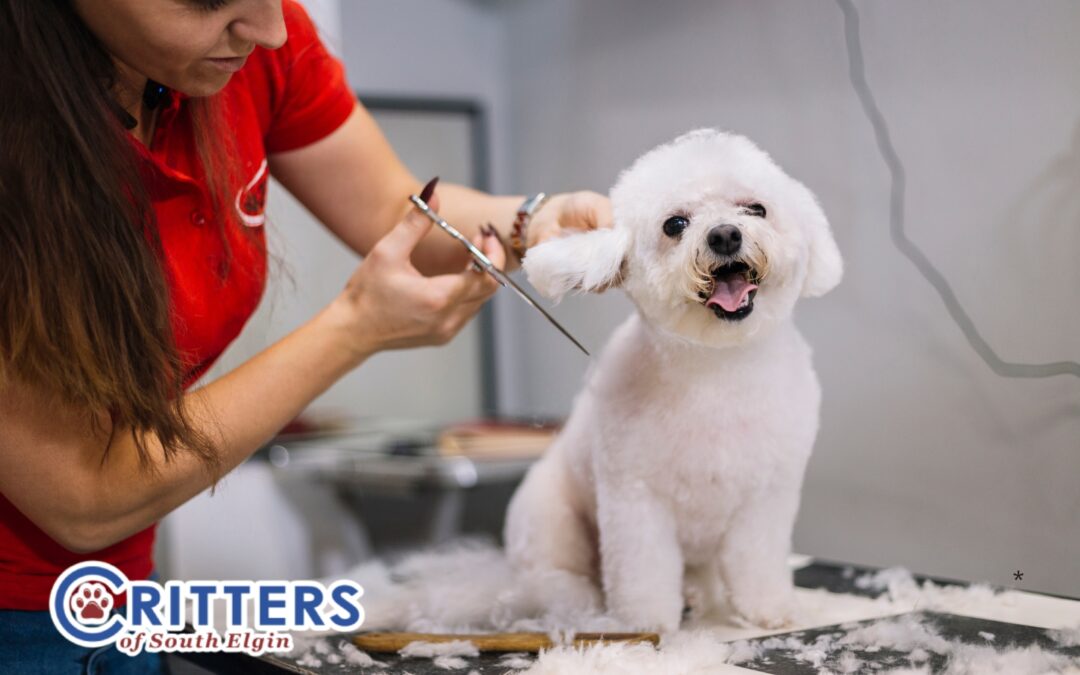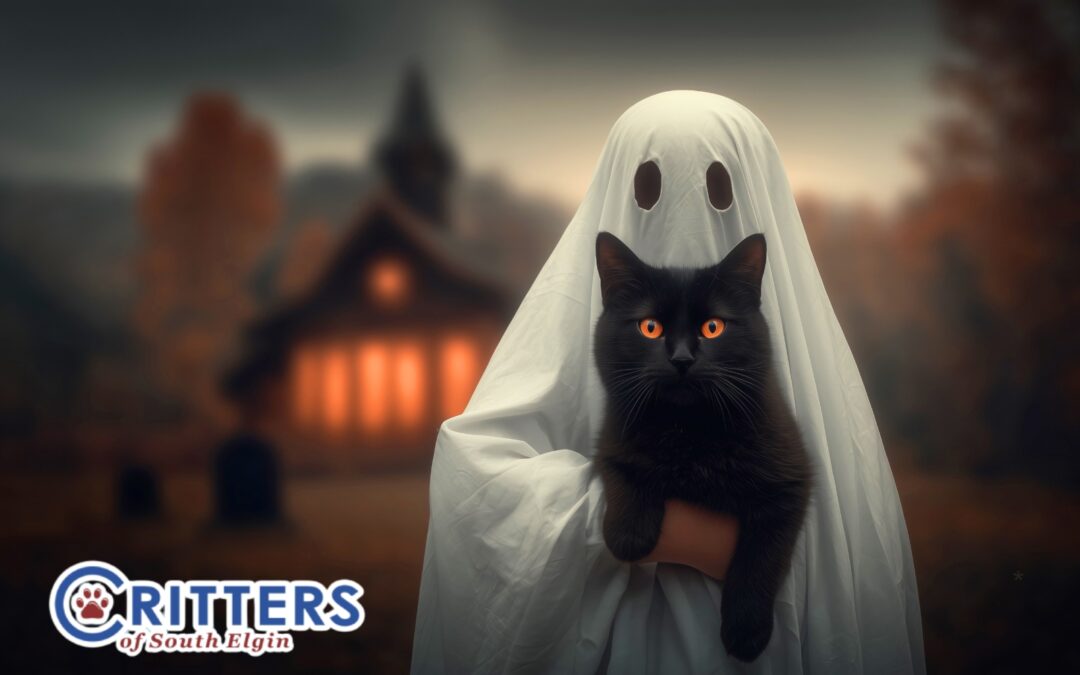
by Critters Pet Shop of South Elgin | Dec 14, 2025 | Uncategorized
When temperatures drop, we bundle up—but your feathered friends rely on you to keep their environment comfortable and safe. Cold weather can be stressful for pet birds, especially smaller species like finches, parakeets, or lovebirds. With a few simple adjustments, you can help your birds stay cozy, active, and healthy all winter long.
- Keep Their Environment Warm
As outdoor temperatures fall, indoor drafts and chill can still affect your bird’s health.
Maintain room temperatures between 65°F and 75°F for most species. Keep cages away from windows, vents, and exterior doors to prevent cold air exposure.
If your home tends to get cool, use a bird-safe ceramic heat emitter or a heated perch to maintain comfort—just make sure your bird can move away from the heat source if it gets too warm.
- Ensure Proper Lighting
Shorter winter days mean less natural sunlight, which can impact your bird’s mood and vitamin D levels. To keep your bird’s internal clock steady, use a full-spectrum bird light for 10–12 hours daily. This helps regulate their sleep cycle and supports feather and bone health.
Transitioning from natural to artificial light can be tricky, so place the light on a timer to mimic sunrise and sunset patterns.
- Provide Fresh, Nutritious Food
Birds burn more calories in colder months as they stay warm. Offer a balanced diet with pellets, fresh fruits, and vegetables. Add a small portion of high-energy treats like seeds or nuts for extra warmth.
Keep food and water dishes clean and avoid placing them near drafts where water might cool quickly. Fresh, room-temperature water is essential—birds need hydration even when it’s cold.
- Maintain Humidity Levels
Winter air tends to be dry, especially with indoor heating. Low humidity can irritate your bird’s respiratory systemand cause brittle feathers or flaky skin.
Use a humidifier in the room or place a shallow dish of water near (but not inside) the cage to help maintain comfortable humidity. You can also lightly mist your bird’s feathers with warm water during the day if they enjoy it.
- Keep Them Mentally Stimulated
When outdoor activity decreases, boredom can set in quickly. Rotate toys weekly, introduce puzzle feeders, and spend quality time with your bird each day.
Even a few minutes of gentle conversation, singing, or training can help maintain their emotional health.
Transitioning into quieter winter months is a great time to bond with your feathered companion!
- Schedule a Wellness Check
Winter is the perfect season for a routine vet visit. Have your bird’s nails, beak, and feathers checked, and discuss any changes in appetite, droppings, or energy. Preventative care keeps small issues from becoming big problems later.
Why Winter Care Matters
Proper winter care helps your bird stay strong, reduces stress, and prevents illness. Birds kept in consistent, warm, and engaging environments are more likely to sing, play, and live long, happy lives.
By taking a few thoughtful steps, you’re not just keeping your bird comfortable—you’re ensuring they thrive, no matter how cold it gets outside.
Key Takeaway
Your bird’s comfort depends on you. Keep their cage warm, maintain humidity, offer nutritious meals, and give them plenty of love and stimulation. Small daily efforts can make a huge difference in your feathered friend’s happiness this winter. For Tips & Tricks, stop into Critters Pet Shop of South Elgin today!

by Critters Pet Shop of South Elgin | Nov 30, 2025 | Tips & Suggestions
The holidays bring a lot of fun, but they also bring new hazards for pets. Between tinsel, chocolate, and visitors coming and going, your home can quickly turn into a minefield for a curious cat or a mischievous dog. Pet-proofing lets you create a space that’s safe for everyone, furry family members included.
Decorate With Your Pet in Mind
Those sparkling ornaments and dangling ribbons may look magical to you, but to your pet, they look like toys. Put delicate glass ornaments higher on the tree and opt for shatterproof ones lower down. Avoid tinsel altogether.
Keep cords and string lights tucked away or secured with cord protectors. Cats love to chew on anything that dangles. And if you’re using a real tree, vacuum up fallen needles frequently so your pets don’t eat them.
Finally, make sure you anchor your tree securely. Dogs can knock it over with one enthusiastic tail wag, and cats might see it as their new climbing challenge.
Be Mindful of Food and Treats
Holiday treats can contain ingredients that are toxic to pets, like chocolate, xylitol (a sugar substitute found in baked goods), grapes, raisins, onions, and alcohol. Even small amounts can cause serious problems.
Keep all food out of reach and remind guests not to feed your pet from the table. If you want to include your pet in the festivities, pick up some seasonal treats made just for them.
Create a Calm, Safe Zone
The holidays can be overwhelming for pets. Give your furry friend a quiet retreat, like a crate, bed, or spare room, where they can get away from the commotion. For anxious pets, a pheromone spray or calming treat can help them feel more at ease when the festivities ramp up.
Candles and Scents
Candles, wax melts, sprays, and potpourri make the season cozy, but they can also pose risks. Always place candles well out of reach and never leave them unattended. Some essential oils and air fresheners (like tea tree oil, cinnamon, and cloves) are toxic to cats and dogs, so stick to pet-safe options.
Have a Happy (and Safe) Holiday Season
The holidays should be full of joy, not trips to the emergency vet. With a little awareness (and maybe a few pet-friendly gifts under the tree), you can celebrate the season knowing your best friend is happy and safe. For Tips & Tricks, stop into Critters Pet Shop of South Elgin today!

by Critters Pet Shop of South Elgin | Nov 14, 2025 | Grooming
As winter sets in, your pet’s coat begins to change, at least if you let their coat do what it’s designed to do. With the right approach, you can keep your pet warm, comfortable, and free from matting or dryness all winter long.
Let the Winter Coat Develop Naturally
Many breeds grow a thicker undercoat when the weather cools, but frequent clipping or shaving can interfere with this process.
If your pet normally sports a shorter cut during the summer, you’ll want to plan ahead for winter. Around early fall, start letting the coat grow out so it has time to develop properly before temperatures really drop. A longer coat traps air close to the body, acting as insulation against the cold.
Brush More, Not Less
It’s easy to assume that winter grooming means less brushing, but that’s exactly when your pet needs it most.
Brushing stimulates natural oils in your pet’s skin, helping prevent dryness, and also removes loose fur and debris so the coat can fluff properly for insulation.
For double-coated breeds, use an undercoat rake or slicker brush to reach down through dense fur. Short-haired dogs and cats still benefit from a good rubber brush or mitt to boost circulation and shine.
Bathing in Winter: Less Is More
Frequent bathing in cold months can strip away the natural oils that protect your pet’s skin and coat. Instead of weekly washes, aim for once a month.
Use lukewarm water, a gentle moisturizing shampoo, and dry your pet thoroughly afterward. A towel followed by a quick blow-dry on a low-heat setting works well.
Trim, Don’t Shave
Winter isn’t the time for a close trim. You don’t want to remove the natural barrier your pet needs to stay warm. But trimming long fur around certain areas helps with cleanliness and comfort:
- Trim hair between paw pads to keep ice, salt, and debris from sticking.
- A neat trim of the hindquarters keeps snow or mud from clinging.
- Keep hair around the eyes and ears short so moisture doesn’t get trapped, which can lead to irritation or infection.
Pay Attention to Indoor Air
Indoor heating systems dry out the air and your pet’s coat along with it. That’s why hydration is part of winter grooming. Make sure your pet always has access to fresh water, and consider using a humidifier to balance the air indoors.
Know Your Pet’s Breed and Coat Type
Not every pet’s coat behaves the same in winter. Double-coated breeds will shed their undercoat in spring and fall, while single-coated breeds rely more on external warmth from clothing or bedding. Short-haired dogs may need a sweater when heading outdoors, while those bred for northern climates often prefer the cold.
As the weather turns frosty, let that coat do what nature intended. With just a bit of upkeep (and maybe some extra cuddles by the heater), your pet will stay cozy and ready to face winter in style. We offer many grooming options for your pets needs at Critters Pet Shop of South Elgin.

by Critters Pet Shop of South Elgin | Nov 1, 2025 | Tips & Suggestions
Whether you’re heading home for the holidays or taking a well-earned vacation, bringing your pet along can make the trip even more special. But traveling with animals takes a bit of planning to make sure everyone stays safe. With the right preparation, you can turn what might feel like a stressful ordeal into a smooth, even enjoyable adventure.
Start With a Pre-Trip Checkup
Before you hit the road (or sky), schedule a quick visit to your vet. Make sure everything’s up to date (vaccinations, microchip information, prescriptions, calming medications, and parasite prevention). Ask for a copy of your pet’s medical records and a health certificate if you’re crossing state or international borders, because many airlines and hotels require it.
Pack a Pet Travel Kit
Just like you pack your own essentials, your pet needs a few things, too. Include:
- Food and treats
- Collapsible bowls
- A leash and waste bags
- Favorite toys
- Bedding or a blanket that smells like home
- Medications, if needed
- A lint roller (trust us on that one)
Make the Carrier or Crate a Comfort Zone
Let your pet explore the carrier at home for a few days before travel. Add toys or a small blanket so they associate it with positive experiences.
For long trips, make sure the crate is large enough for your pet to stand, turn around, and lie down comfortably. Label it clearly with your contact info, and never use it for punishment.
Road Trips: Plan for Breaks
When driving, stop every few hours to let your pet stretch their legs, get some water, and use the bathroom. Never leave your pet alone in the car, either. Temperatures can rise or drop dangerously fast, even if it feels mild outside. For pets new to travel, take a few short practice drives first to help them adjust to motion and car sounds.
Flying With Pets
If you’re flying, check the airline’s pet policy early, because rules vary widely. Some let small pets into the cabin, while others require cargo travel. Book direct flights when possible, and choose early morning or evening flights to avoid extreme temperatures.
Settling In at Your Destination
When you get there, give your pet time to explore their new surroundings. Keep routines as consistent as possible. If you’re staying in a hotel or rental, check the space for potential hazards. It also helps to bring familiar scents from home, like a worn T-shirt, toy, or their regular bed.
Safe Travels for Everyone
Think of the journey through your pet’s eyes. New sounds, smells, and sights can be exciting but overwhelming. Plan ahead and you’ll make those trips fun and safe for everyone. For Tips & Tricks, stop into Critters Pet Shop of South Elgin today!

by Critters Pet Shop of South Elgin | Oct 15, 2025 | Uncategorized
Halloween can completely change the rhythm of your home. One day it’s calm and predictable, and the next it’s buzzing with decorations, candy, and a steady knock at the door. For us, it’s exciting. For pets, it can feel confusing and even overwhelming.
Costumes, treats, and constant activity can create situations that aren’t always safe for animals. Thinking through their comfort and environment ahead of time will help them get through the night without unnecessary stress.
Picking Pet Costumes That Are Cute Without Restricting Movement
If your pet is going to dress up, make sure the costume fits well and doesn’t limit movement. They should be able to walk, sit, and lie down without trouble. Avoid outfits that block their vision, make it hard to breathe, or have small parts that can be chewed off. Always keep an eye on them while they are wearing it, and remove it if they seem uncomfortable.
Hidden Dangers in Halloween Candy and Decorations
Chocolate is harmful to dogs, but many other sweets can cause problems too.
Sugar-free candy often contains xylitol, which is toxic to both dogs and cats. Wrappers, lollipop sticks, and hard candies can lead to choking or stomach issues. Decorations can be risky as well. String lights, fake cobwebs, and small props may look festive, but can be dangerous if chewed or swallowed.
Managing Doorbell Traffic and Trick-or-Treater Stress for Pets
The constant sound of visitors can make pets anxious. Dogs may bark at every noise, and cats might disappear to the quietest corner they can find.
Give them a safe space away from the front door, stocked with their bed, fresh water, and a favorite toy. Playing music or leaving the television on can help cover the noise and keep them more relaxed.
Safe Alternatives to Include Your Pet in the Festivities
If your pet enjoys being part of the action, there are safe ways to involve them. Take them for a short walk in a comfortable costume before the streets get crowded. Offer pet-safe treats or create a small photo spot at home to capture the moment. This way, they can still share in the fun without being exposed to the more stressful parts of the night.
With the correct setup, you can enjoy Halloween while keeping your pet safe, calm, and comfortable. Contact Critter Pet Shop for more information!





